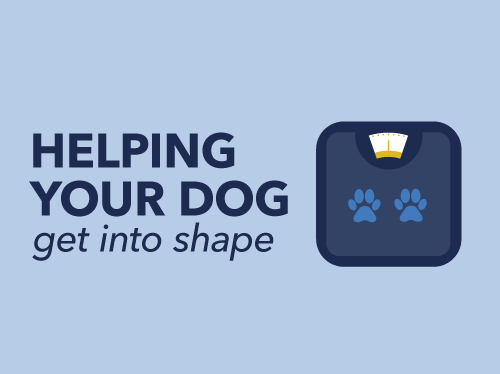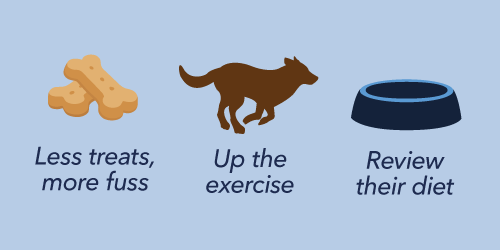We can all be guilty of a little overindulging now and then, whether it’s an extra biscuit or an extra helping of dessert. But when those over indulgences lead to quite a bit of weight gain, we can put ourselves at risk of damaging our health. Just as it is for humans, obesity in dogs is also a health risk. If you think your dog needs a little help to get back into shape, here’s what you need to do:

Get everybody on board
First of all, everyone in your house needs to be on board. It’s no good if only one of you is taking the diet seriously, whilst others continue to feed treats! Try creating a feeding chart so that when your dog has been fed their meals and daily treat, everyone in the house knows too.
Swap out treats for attention
A good rule of thumb to remember is: treats shouldn’t make up more than 10% of a dog’s daily calorie intake. The occasional treat can be good for your dog when combined with training or if given for a nutritional benefit. When treats become too much of a regular occurrence, they can contribute to weight gain and for many dogs, it’s actually the attention that they appreciate more than the treat itself. So when they turn those puppy dog eyes on you, swap the usual treat for an affectionate scratch, cuddle or play time session.
Increase exercise
Every healthy dog should be able to manage at least 20 minutes of walking, twice a day. Getting out and about for walks doesn’t just provide your dog with the physical exercise they need, it also provides mental stimulation. If you’re looking to get your dog into shape, begin by gradually increasing the length of their usual walk by an extra 5-10 minutes each week. If your dog is already fairly active, try changing their usual exercise routine and adding other exercises like swimming. Swimming is a great way for a dog to exercise without putting any excess stress or strain on their joints, but not all dogs are built for it. Read our tips for taking your dog swimming.
Change or review your dog’s diet
For some dogs, it’s simply the lack of exercise that contributes to their weight gain. For others, however, they may require a change in diet. This could mean looking at a low fat, high fibre diet to help your dog stay fuller for longer with fewer calories or simply tweaking the amounts or type of treats they usually get each day. If you’re prone to overfeeding, you may need to reassess your dog’s portion sizes. If you feed human foods to your pet occasionally, you should consider cutting this out too as this has a big impact on a dog’s’ weight – more so than you might expect!

What if he’s still hungry?
If your dog is used to eating bigger portions, it’s likely that extra bit of food will be missed when it’s reduced. The body soon adapts, however, and as we mentioned earlier, it’s the attention that comes with the feeding that can be more satisfying for your dog than the food itself.
Things to remember:
Every dog is different and what works for one dog may not work for another. If your dog is a tails.com dog, keeping their profile up to date with regular weight and condition updates will mean that their feeding plan will adjust to cater for their target weight. If you’re concerned about your dog’s weight, drop us an email at hello@tails.com and we can talk about a plan that’ll work for you both.
Worried your dog may be overweight? We’d recommend checking their body condition score.
What are the risks of your dog being overweight?
Obesity in dogs can lead to a number of further problems, including:
- Arthritis
- Diabetes
- Heart problems
- High blood pressure
- Respiratory issues
- Increased risk of developing certain tumours
- Higher risk should your dog need anaesthetic during surgery
- Lower quality of life
- Shorter life expectancy
Feeding the right amount of high-quality food to keep your dog at the correct weight can expand their lifespan by up to two years. A healthy dog is a happy dog, and life will be far more enjoyable for the both of you if you’re both in shape.


I let you know my labrador tends to be over weight mainly because he looks so sweetly at visitors they all give biscuits, but since you changed his diet he is getting lighter Thank you
My dog is coming up 12 this December, he has arthritis in his back legs.
He manages 10-15 minutes walk in the evening.
I am weighing his food out after speaking to the vets.
He doesn’t enjoy dry food, so we mix it with a small 100g pouch of wet food.
I have calculated the weight difference in dry food.
He has a tumour on his pituarity gland, he is on medication for this and other ailments he has developed.
His treat is a small crunchy bone of carrot and cranberry once a day.
He did have a daily treat of the purina dental stick, ( only 1) until I found out how many calories were in them!
His weight is 39kg, hoping to get him down to at least 35kg (vets advice)
Any advice is appreciated.
Denise
Hi Denise,
Please get in contact with our customer support team hello@tails.com they will be able to put you in touch with our nutrition team to support and provide helpful dietary advice.
Thanks
Ellie
Hi I would like to try the two weeks free I have a 6 month old shitzu
Hi Janet, that’s great to hear you’d like to try our 2 week free trial. Please click and sign up through the following link